Lemon balm
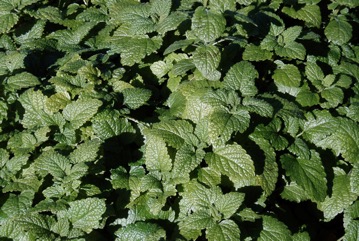
It is a temperate plant. It does best on light, well-drained soils. It needs an open sunny position but can grow in light shade. It can tolerate drought and frost. It benefits from well composted soil. It grows in Europe up to 60° north. In Hobart Botanical gardens. In the tropics it is grown in mountainous regions. It suits plant hardiness zones 5-9. Tasmania Herbarium.
Also known as:
Balm mint, Barambo, Bee balm, Cedronella, Citromfu, Citronnelle, Erbe limone, Hallall perajenana, Limon otu, Maticnjak, Melissa, Melisse, Menta limona, Ogulotu, Sweet balm, Swre helale, Tarongina, Toronjil, Xiang feng hua, Zozak
Synonyms
- Melissa altissima J.E.Smith
- Melissa inodora Bornm. non Hassk.
- Melissa romana
Edible Portion
- Leaves, Herb, Spice, Leaves - tea
Where does Lemon balm grow?
Found in: Africa, Albania, Argentina, Asia, Australia, Balkans, Bosnia, Britain, Bulgaria, Canada, Caucasus, Central America, Central Asia, Chile, China, Congo DR, Crete, Croatia, Cyprus, Europe, France, Georgia, Greece, Hungary, India, Indonesia, Iran, Iraq, Italy, Kyrgyzstan, Lithuania, Macedonia, Mediterranean, Morocco, North Africa, North America, Pacific, Panama, Pakistan, Papua New Guinea, PNG, Philippines, Portugal, Romania, Russia, SE Asia, Serbia, Slovenia, South America, Spain, Sweden, Switzerland, Tajikistan, Tasmania, Turkey, Turkmenistan, Uruguay, United States, Uzbekistan, Yugoslavia
Notes: There are about 4 Melissa species.
Status: In Papua New Guinea it occurs in some highland gardens.
Growing Lemon balm
Cultivation: It can be grown from seeds or division of the root. Seed are slow to start growing. It can also be grown by tip cuttings which are put into water to form roots. The flowers should be picked off. Plants can be cut back to near ground level and allowed to regrow.
Edible Uses: The lemon flavoured leaves are used for drinks or flavouring foods and is used either raw or cooked. They can be used in salads. It is also used to flavour liqueurs. It is added to meat and vegetable dishes. It is used in soups and sauces. The leaves can be used for tea.
Production: It is best used fresh.
Nutrition Info
per 100g edible portion| Edible Part | Energy (kcal) | Protein (g) | Iron (mg) | Vitamin A (ug) | Vitamin c (mg) | Zinc (mg) | % Water |
|---|---|---|---|---|---|---|---|
| - | - | - | - | - | - |
Lemon balm Photos

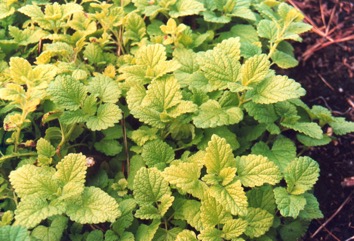
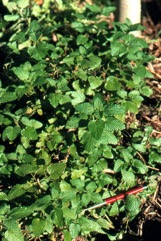
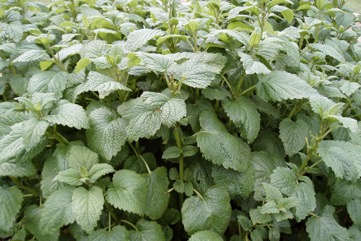
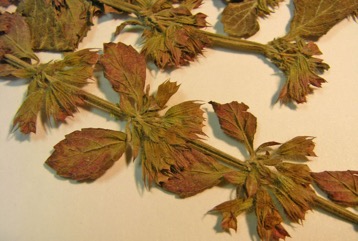
References
Abbet, C., et al, 2014, Ethnobotanical survey on wild alpine food plants in Lower and Central Valais (Switzerland). Journal of Ethnopharmacology 151 (2014) 624–634
Ahmad, S. A. & Askari, A. A., 2015, Ethnobotany of the Hawraman Region of Kurdistan Iraq. Harvard Papers in Botany, Vol. 20, No. 1, 2015, pp. 85–89.
Ambasta, S.P. (Ed.), 2000, The Useful Plants of India. CSIR India. p 363
Bianchini, F., Corbetta, F., and Pistoia, M., 1975, Fruits of the Earth. Cassell. p 204
Blamey, M and Grey-Wilson, C., 2005, Wild flowers of the Mediterranean. A & C Black London. p 397
Blanco-Salas, J., et al, 2019, Wild Plants Potentially Used in Human Food in the Protected Area “Sierra Grande de Hornachos” of Extremadura (Spain). Sustainability 2019, 11, 456 (As subsp. altissima)
Bodkin, F., 1991, Encyclopedia Botanica. Cornstalk publishing, p 694
Bonet, M. A. & Valles, J., 2002, Use of non-crop food vascular plants in Montseny biosphere reserve (Catalonia, Iberian Peninsula). International Journal of Food Sciences and Nutrition (2002) 53, 225–248
Bremness, L., 1994, Herbs. Collins Eyewitness Handbooks. Harper Collins. p 189
Brickell, C. (Ed.), 1999, The Royal Horticultural Society A-Z Encyclopedia of Garden Plants. Convent Garden Books. p 667
Burnie, G & Fenton-Smith, J., 1999, A Grower's Guide to Herbs. Murdoch Books. p 44
Cerne, M., 1992, Wild Plants from Slovenia used as Vegetables. Acta Horticulturae 318
Cheifetz, A., (ed), 1999, 500 popular vegetables, herbs, fruits and nuts for Australian Gardeners. Random House p 134
Ciftcioglu, C. G., 2015, Sustainable wild-collection of medicinal and edible plants in Lefke region of North Cyprus. Agroforest Syst. Springer
Crawford, M., 2012, How to grow Perennial Vegetables. Green Books. p 123
Cundall, P., (ed.), 2004, Gardening Australia: flora: the gardener's bible. ABC Books. p 888
Curtis, W.M., 1993, The Student's Flora of Tasmania. Part 3 St David's Park Publishing, Tasmania, p 546
Dashorst, G.R.M., and Jessop, J.P., 1998, Plants of the Adelaide Plains & Hills. Botanic Gardens of Adelaide and State Herbarium. p 126
Denes, A., et al, 2012, Wild plants used for food by Hungarian ethnic groups living in the Carpathian Basin. Acta Societatis Botanicorum Poloniae 81 (4): 381-396
Dolina, K. & Luczaj, L., 2014, Wild food plants used on the Dubrovnik coast (south-eastern Croatia) Acta Soc Bot Pol 83(3):175–181
Ertug, F., 2004, Wild Edible Plants of the Bodrum Area. (Mugla, Turkey). Turk. J. Bot. 28 (2004): 161-174
Ertug, F, Yenen Bitkiler. Resimli Türkiye Florası -I- Flora of Turkey - Ethnobotany supplement
Esperanca, M. J., 1988. Surviving in the wild. A glance at the wild plants and their uses. Vol. 2. p 52
Facciola, S., 1998, Cornucopia 2: a Source Book of Edible Plants. Kampong Publications, p 127
Flora of Pakistan. www.eFloras.org
French, B.R., 1986, Food Plants of Papua New Guinea, A Compendium. Asia Pacific Science Foundation p 364
Hancer, C. K., et al, 2020, Traditional Knowledge of Wild Edible Plants of Biga (Çanakkale), Turkey. Acta Societatis Botanicorum Poloniae / 2020 / Volume 89 / Issue 1 / Article 8914
Hedrick, U.P., 1919, (Ed.), Sturtevant's edible plants of the world. p 409
Hemphill, I, 2002, Spice Notes. Macmillan. p 55
Hibbert, M., 2002, The Aussie Plant Finder 2002, Florilegium. p 196
http://www.botanic-gardens-ljubljana.com/en/plants
Kayabasi, N. P., et al, 2018, Wild edible plants and their traditional use in the human nutrition in Manyas (Turkey). Indian Journal of Traditional Knowledge. Vol. 17(2), April 2018, pp 299-306
Kiple, K.F. & Ornelas, K.C., (eds), 2000, The Cambridge World History of Food. CUP p 432, 1730, 1800,
Kizilarslan, C. & Ozhatay, N., 2012, An ethnobotanical study of the useful and edible plants of İzmit. Marmara Pharmaceutical Journal 16: 134-140, 2012.
Kybal, J., 1980, Herbs and Spices, A Hamlyn Colour Guide, Hamlyn Sydney p 128
Lawton, B.P., 2002, Mints. A Family of Herbs and Ornamentals. Timber Press, Portland, Oregon. p 148
Lazarides, M. & Hince, B., 1993, Handbook of Economic Plants of Australia, CSIRO. p 162
Li Hai-wen, Hedge, I.C., Lamiaceae. Flora of China. p 298
Luczaj et al, 2013, Wild vegetable mixes sold in the markets of Dalmatia (southern Croatia). Journal of Ethnobiology and Ethnomedicine. 8:2
Luczaj, L. et al, 2017, Comfrey and Buttercup Eaters: Wild Vegetables of the Imereti Region in Western Georgia, Caucasus. Economic Botany, 71(2), 2017, pp. 188–193
Mabey, R., 1973, Food for Free. A Guide to the edible wild plants of Britain, Collins. p 140
Michael, P., 2007, Edible Wild Plants and Herbs. Grub Street. London. p 16
Nassif, F., & Tanji, A., 2013, Gathered food plants in Morocco: The long forgotten species in Ethnobotanical Research. Life Science Leaflets 3:17-54
Pieroni, A., 1999, Gathered wild food plants in the Upper Valley of the Serchio River (Garfagnana), Central Italy. Economic Botany 53(3) pp 327-341
Pieroni, A., et al, 2017, The spring has arrived: traditional wild vegetables gathered by Yarsanis (Ahl-e Haqq) and Sunni Muslims in Western Hawraman, SE Kurdistan (Iraq). Acta Soc Bot Pol 86(1):3519
Plants for a Future database, The Field, Penpol, Lostwithiel, Cornwall, PL22 0NG, UK. http://www.scs.leeds.ac.uk/pfaf/
PROSEA handbook Volume 13 Spices. p 257
Redzic, S. J., 2006, Wild Edible Plants and their Traditional Use in the Human Nutrition in Bosnia-Herzegovina. Ecology of Food and Nutrition, 45:189-232
Sansanelli, S., et al, 2014, Wild food plants traditionall consumed in the area of Bologna (Emilia Romagna region, Italy). Journal of Ethnobiology and Ethnomedicine 10:69
Sp. pl. 2:592. 1753
Tasmanian Herbarium Vascular Plants list p 36
Tardio, J., et al, Ethnobotanical review of wild edible plants in Spain. Botanical J. Linnean Soc. 152 (2006), 27-71
Tronickova, E. & Krejcova, Z., 1987, Ortaggi, Instituto Geografico de Agostini, Cecoslovacchia. p 202
van Wyk, B., 2005, Food Plants of the World. An illustrated guide. Timber press. p 244
World Checklist of Useful Plant Species 2020. Royal Botanic Gardens, Kew